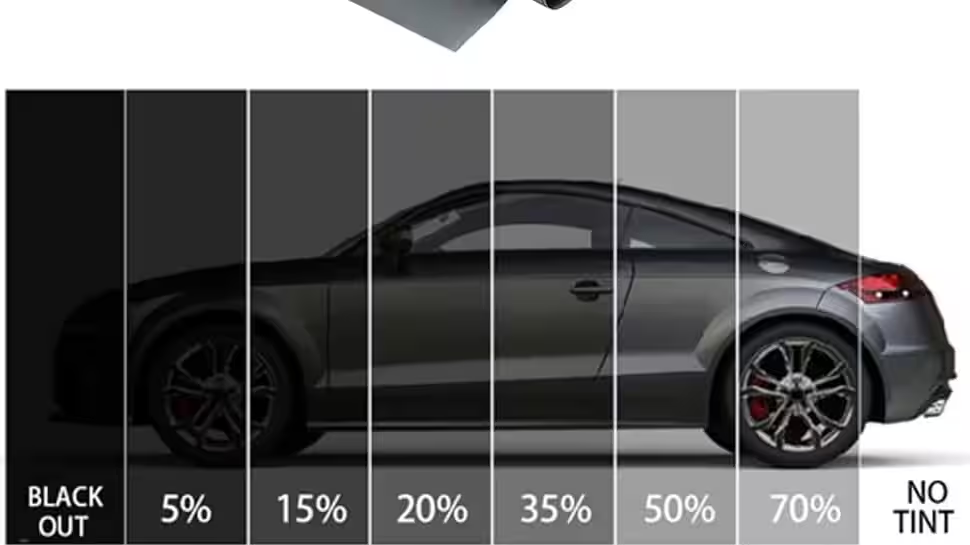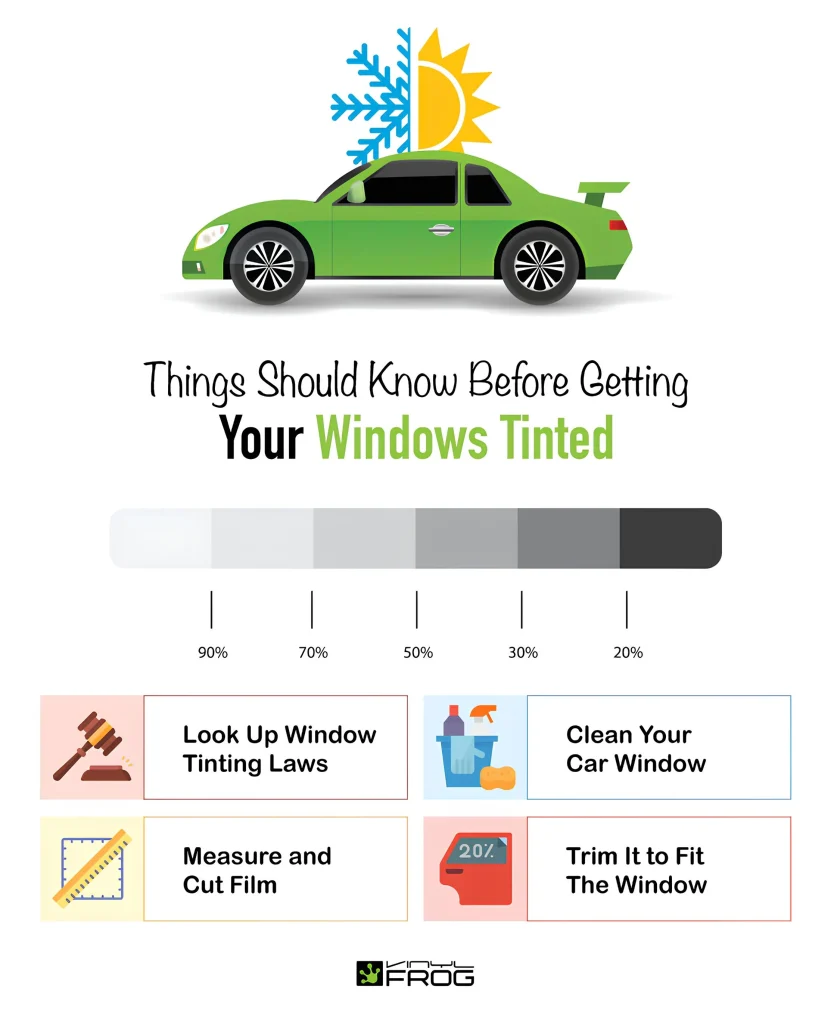
In determining how much to tint car windows, one needs to balance so much in style, privacy, protection from the UV rays, and legal requirements. The benefits of how much to tint car windows range from reduction of glare and protection for the upholstery interior to increased safety and privacy when driving. However, with this information, a decision would be made based on knowing what level of tinting suits your needs and what regulations are applicable in your area.
Why Tinting Matters: The Key Benefits of Car Window Tinting
How much to tint car windows? There is no doubt that windows look great when tinted. Here are the top benefits of how much to tint car windows:
- Privacy and Security: No one can peek inside your car, which will protect your belongings and offer you some level of personal privacy.
- Reduced Heat: Often, a tint can significantly reduce heat inside the car. This is especially important in hot climates where a cooler interior environment is needed.
- UV Protection: High-quality tints can block as much as 99% of the sun’s damaging UV rays thus preventing damage to both occupants and the interior car from the sun.
- Less Glare: Tinting reduces glare from the sun and from headlights that make the journey convenient as well as safe.
- Safety: During an accident, broken glass from the tinted windows holds together thus not posing a serious threat in case of injuries.
Keeping all these in mind, it’s now time to understand the different levels of tinting and what considerations to have when selecting the right amount of tint for your vehicle.
How much to tint car windows: Window Tint Levels Explained
How much to tint car windows? Window tint levels are measured in percentages how much light the film allows through. That’s called Visible Light Transmission (VLT). A 50% VLT allows 50% of the light to pass-through; a 5% VLT, more commonly known as “limo tint”, permits only 5% of the light to pass-through.
Common Tint Levels Quick Summary of how much to tint car windows:

- 5% Tint: Also known as limo tint, it is the darkest level of tint that provides maximum privacy. This type of tint usually illegal on front windows due to low visibility.
- 15-20% Tint: Extremely dark and widely used on back windows in order to provide increased privacy, though it remains illegal in many regions for usage on front windows.
- 35% Tint: Medium to dark, offers maximum privacy but is still pretty transparent for driving. Generally allowed at front side windows in most states.
- 50% Tint: More of a light tint, and will take away glare and UV rays while barely affecting the clarity of the glass. Generally okay for all local locations.
- 70% Tint: Very minimal that will do its part at keeping UV and heat off your window without changing the tint too much at all.
Things to Consider When Choosing Your Tint Level
To make your best choice on how much to tint car windows, consider these important factors:
1. Local Tint Laws and Regulations
How much to tint car windows i.e. tinting laws vary widely across the country and are typically more limiting on front windows than back ones. In places that do allow dark tints, some localities allow only very light shades of tint on front windows in order to preserve a driver’s ability to see.
- Front Side Windows: Most places have a higher VLT requirement that should be 50% or higher to ensure safe view.
- Windshield: In some places, they will only allow you to have a shade on the top portion, usually within the first 4-6 inches.
- Rear Side and Back Windows: Tints here are not normally strict, but darker tinted windows are usual for acquiring increased privacy.
- Research Your State or Country Laws: Many states have restricted tints to certain levels. Always check the restrictions of your state or country to ensure the tint level you have chosen does not break any local laws. This can lead to fines or, worse, having to remove the tints.
2. Purpose for Window Tinting
- Confidentiality: When personal privacy is a concern, you will want a 20% or darker tint for rear and sides.
- Aesthetics: Others prefer that more sleek look of a darker tint. Still, finding that balance point between legal limits and practicality is key.
- Heat and UV Protection: Lighter tints (50% or higher) can still block UV rays and reduce heat without darkening the windows beyond view.
3. Visibility and Driving Conditions
Darker shades lower visibility, especially in dim light. A 20% or 5% tint on side or rear windows will make it much more difficult to back up and see around your vehicle at night. This is the very opposite of what you probably want. How much to tint car windows depends on your typical driving conditions-you probably drive some nights, and maybe even some rain days-so visibility is an important factor for you. Choose a lighter tint and be ready to spend a little extra.
4. Type of Window Tint Film
How much to tint car windows also depends on what type of window tint film you’re using. All window tint films are not created equal. Here are just a few:
- Dyed Window Tint: The cheapest, it will leave you looking dark but doesn’t last long.
- Metalized Film: Offers you extra strength and durability. At times though, this kind of window tint is interfering with electronic signals
- Carbon Window Tint: Blocks out ultraviolet light rays and resists fading better than dyed film, with a sleek matte finish.
- Ceramic Film: A quality film that blocks UV rays, reduces glare without interfering with electronic devices; typically the most expensive.
Finding the Right Percentage for Each Window’s Tint
The type of window dictates how much to tint car windows. Here is the variation in ideal tint percentages based on the benefits they offer and typical legal allowances:
1. Front Side Windows
- Recommended Tint: 35-50% VLT
- Reasoning: A medium or light tint will introduce some heat and UV protection while staying below legal limits. In most areas, front windows must allow for more light for the purpose of allowing the driver to be seen.
2. Rear Side Windows
- Recommended Tint: 15-35% VLT
- Reasoning: Privacy is usually the larger issue when it comes to back passengers. Darker tints are desirable in this area; a 15-20% tint is best for privacy purposes yet admits enough light to see.
3. Back Window
- Recommended tint: 5-20% VLT
- Reasoning: This window can often be the darkest if the needs for privacy and UV protection are very strong. A 5% or limo tint provides maximum privacy, but can be too dark for some drivers.
4. Windshield
- Recommended tint: 70% VLT or a 4-6 inch tinted strip at the top
- Rationale: For the glass to allow transparency while giving light, most jurisdictions only allow it to be tinted with some ultraviolet protection and hardly permit any strong colors. Most drivers love a strip across the top to get rid of overhead sunlight glare without obstructing view in the strong field of vision.
Laws and Safety Considerations around Auto Window Film Tinting
Laws Compliant
Failure to comply with the regulations on tinting as stipulated by a state or local government may cost you fines and probable legal wrangles therefore it is important to understand how much to tint car windows. In some states, enforcement officers will issue a citation, depending on how dark the tints are on your windows. Repeated offences may compel you to remove the tints, which can be costly and time-consuming.
Insurance Considerations
Few insurance companies cover a vehicle which holds illegal tinting. Therefore, consult with your insurance company to determine how much to tint car windows, whether and in what manner tinting may have any effect on your insurance coverage, if you are considering darkening beyond recommended limits.
Visibility at Night
Darker tints limit view at night or under bad weather. You can opt for a medium or lighter tint on the front windows so that sight will become even clearer during the dimmest conditions and it would be easier to know how much to tint car windows.
Some Tips on Car Window Tint Selection and Application
Once you have decided on the percentage of your car window tint, here are some tips to ensure how much to tint car windows correctly:
- Choose a Professional Installer: Properly applied and well-installed tints prevent the common vices involved which include bubbles and peeling, especially after improper uniform application. They will also be aware of the local laws and can guide you regarding compliant levels of tint available.
- Invest in Quality Tint Film: These films give higher protection against UV rays, and fade much later with fewer possibilities. Even though you spend more money upfront, quality films last much longer, and the maintenance is quite minimal.
- Get a Warranty: Most good professional installers are offering some warranty not just on the work but the film itself. That gives you peace of mind from bubbling or peeling in the far future.
- Avoid Do-it-yourself Kits if Not Experienced on Installation: Do-it-yourself kits can be very enticing, but professional installation would make your car look so much better. Tinting does take experience, and when applied wrong, it’s too heavy and tough and maybe expensive to fix.
- State-specific Exemptions: Some states do allow medical exemptions if you need those darker tints due to certain health concerns that call for UV protection. Check if you qualify if you need such tints for health purposes.
Window Tint Maintenance and Care

Take good care of your window tint to ensure it lasts long and stays good as new as the day it was installed. Here’s how much to tint car windows with care:
- Wait Before You Clean Up The tinted windows: After installation, take some time to clean, as a few days are needed for the film to set.
- Avoid the Film Scratches: Do not roll up and down the windows with abrasive particles and sharp tools on the tint
- Ammonia-Free Cleaners: Tint film is damaged by ammonia. Use a soft cloth and a cleaner on specifically tinted windows
Conclusion: Finding Your Ideal Tint Level
Determining how much to tint car windows requires juggling between keeping your self private, protecting you from the harsh rays of the sun and UV rays and maintaining your visibility, meanwhile adhering to the local regulations. So, you can simply do that by considering the benefits, the legal limits, and finally what suits your aesthetic before making a proper choice. Quality tinting materials and professional installation are also paramount in ensuring that it lasts and performs effectively.
How much to tint car windows? Whether you’re looking to add some privacy, reduce glare, or just give your car a refreshed look, the correct level of tint can help you achieve just that right blend of form and function. It is able to make driving so much easier as it becomes safer and more aesthetically pleasing. You can check other guide to know How to avoid rats in car?